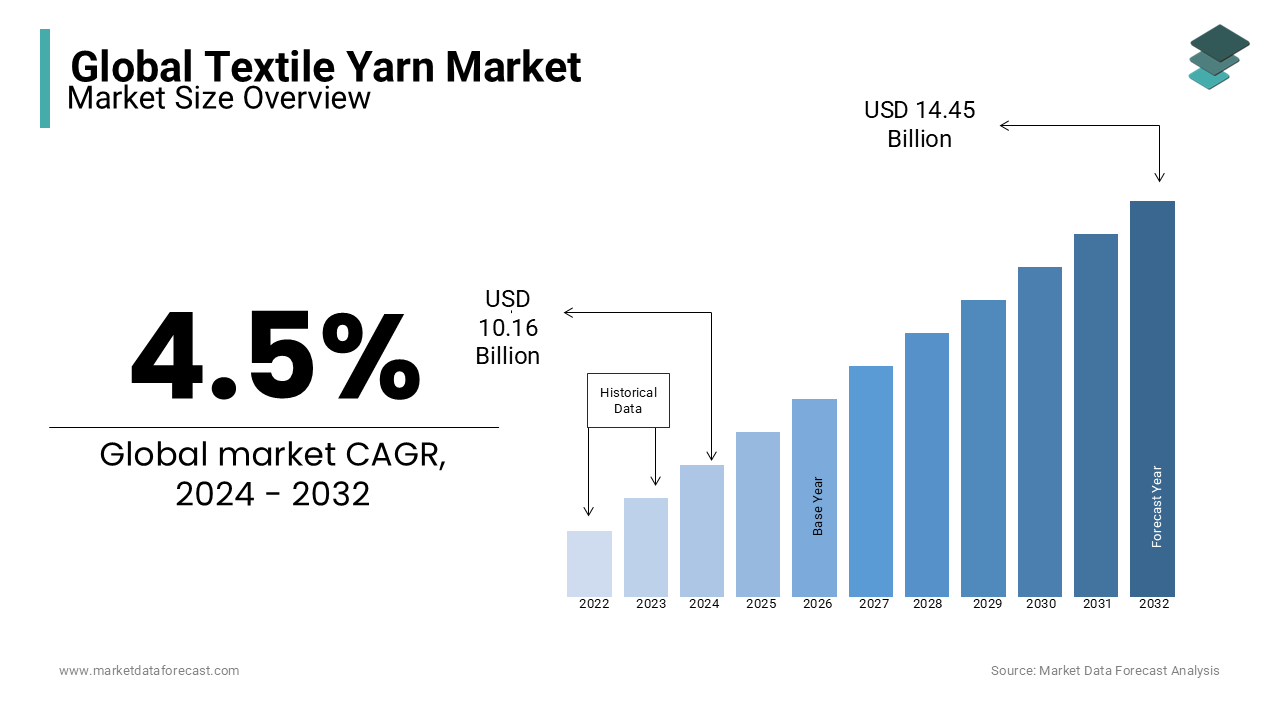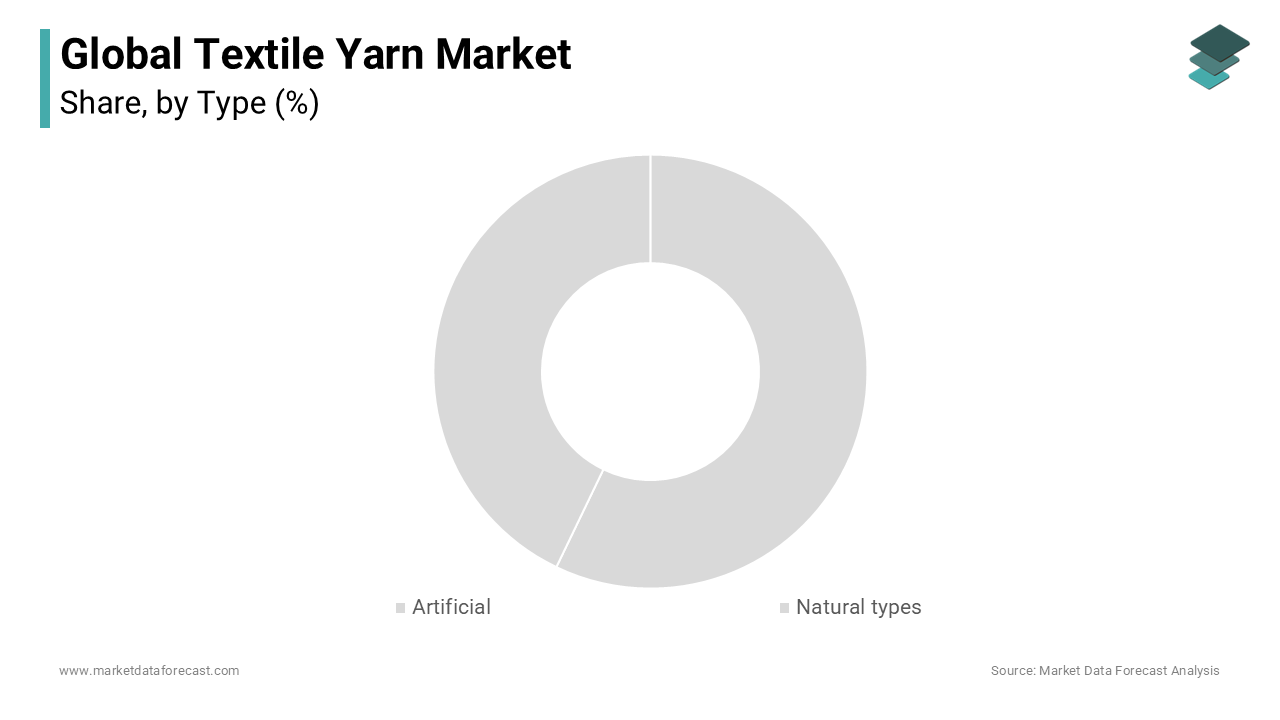Global Textile Yarn Market Size, Share, Trends & Growth Forecast Report– Segmented By Source (Chemical, Animal, Plant and Others), Application (Home Textile, Apparel and Industrial), Type (Artificial (Viscose, Polyester, Acrylic, And Nylon), Natural (Flax, Wool, Ramie, Cotton, Hemp, Jute and Silk), and Region (North America, Europe, Asia-Pacific, Latin America, Middle East and Africa) – Industry Analysis from 2024 to 2032
Global Textile Yarn Market Size (2024 to 2032)
The Global textile yarn market was valued at USD 9.72 billion in 2023. The global market size is expected to grow at a CAGR of 4.5% from 2024 to 2032 and be worth USD 14.45 billion by 2032 from USD 10.16 billion in 2024.

Current Scenario of the Global Textile Yarn Market
Cotton is the most common natural fiber. At the same time, synthetic fibers are available; the three forms are filament, staple, and tow. Filament and spun are basic forms of textile yarn.
The thread is quite a textile yarn specially intended for stitching by machine or hand. Embroidery threads are the kind of textile yarns that are meant for machine or hand embroidery. The textile yarn is formed of numerous synthetic or natural fibers. Natural fibers are a little elastic and intensely breathable.
A continuous length of long interlocked fibers is understood as yarn employed in the assorted processes of textile production like weaving, sewing, embroidery, rope making, knitting, and crocheting. The thread is quite a textile yarn specially intended for stitching by machine or hand. Embroidery threads are the sort of textile yarns that are intended for machine or hand embroidery. The textile yarn is created from numerous synthetic or natural fibers. Natural fibers are a little elastic and intensely breathable. Cotton is the most common natural fiber, while synthetic fibers are available in three forms: filament, staple, and tow. Filament and spun are basic styles of textile yarn.
MARKET DRIVERS
Factors like urbanization, high increment, and a growing middle-class population with higher income are forecasted to drive market growth.
Due to increasing consumer awareness regarding the standard of textile yarn, the demand for various products is anticipated to spice up market growth within the forecast period. The textile yarn market is predicted to witness significant growth over the forecast period due to the increasing awareness of the benefits of textile yarn. The rise in income across the key geographies has also impacted the market positively.
Rapid growth within the urbanization and increasing requirements of the industries are the main factors that anticipate driving the market growth. The shifting trend towards affordable clothing such as viscose, silk, and hemp is likely to bolster the growth rate of the market. The shift in consumer preference towards affordable and cozy clothing increases the demand for high-value fabrics like viscose, silk, and hemp. Blended sorts of fibers are also taking immense growth within the market, thus opening new growth opportunities within the coming years.
MARKET RESTRAINTS
However, instability within the production of plant and animal source yarn and the strict regulation that is imposed on the trade of textile yarn products restraints the world textile yarn market to some extent. Textile is one of the essential needs of the human population. The textile industry is experiencing high demands in Asia Pacific regions due to the population explosion. The adoption of recent trends globally and the introduction of recent fabrics are several of the main factors driving demand for textile yarns. One of the main challenges that might affect the market growth is the presence of counterfeit products. The market is witnessing the competition of a surging number of alternative products that use inferior ingredients.
REPORT COVERAGE
|
REPORT METRIC |
DETAILS |
|
Market Size Available |
2023 to 2032 |
|
Base Year |
2023 |
|
Forecast Period |
2024 to 2032 |
|
CAGR |
4.5% |
|
Segments Covered |
By Source, Application, Type and Region |
|
Various Analyses Covered |
Global, Regional and Country Level Analysis; Segment-Level Analysis, DROC; PESTLE Analysis; Porter’s Five Forces Analysis, Competitive Landscape; Analyst Overview of Investment Opportunities |
|
Regions Covered |
North America, Europe, Asia Pacific, Latin America, Middle East & Africa |
|
Market Leader Profiled |
Parkdale Mills Incorporated, Hengli Group, Kairuide Hulding Co Ltd., Vardhman Textiles Limited, Birleik Koyunlulular Mensucat TIC. V., Weiqiao Textile Company Limited, E SAN., Low & Bonar Plc., Raymond Limited, Huvis Corporation and Grasim Industries Limited |
SEGMENTAL ANALYSIS
Global Textile Yarn Market By Type

The natural segment is leading with a significant share of the global market, whereas the artificial segment is anticipated to have the highest CAGR in the coming years.
KEY MARKET PLAYERS
Parkdale Mills Incorporated, Hengli Group, Kairuide Hulding Co Ltd., Vardhman Textiles Limited, Birleik Koyunlulular Mensucat TIC. V., Weiqiao Textile Company Limited, E SAN., Low & Bonar Plc., Raymond Limited, Huvis Corporation and Grasim Industries Limited are some of the noteworthy companies in the global textile yarn market.
DETAILED SEGMENTATION OF THE GLOBAL TEXTILE YARN MARKET INCLUDED IN THIS REPORT
This research report on the global textile yarn market has been segmented and sub-segmented into the following categories.
By Type
- Artificial
- Natural types
- Flax
- Wool
- Ramie
- Cotton
- Hemp
- Jute
- Silk
- Others
By Source
- Chemical
- Animal
- Plant
- Others
By Application
- Home textile
- Apparel
- Industrial
By Region
- North America
- Europe
- Asia Pacific
- Latin America
- The Middle East and Africa
Frequently Asked Questions
What is the current size of the textile yarn market?
The global textile yarn market size was valued at USD 9.3 billion in 2022.
What are the key factors driving the growth of the textile yarn market?
The growing demand for sustainable textiles, advancements in textile technology, and the fashion industry's evolution are majorly driving the growth of the textile yarn market.
Which regions are the primary consumers of textile yarns?
Major consumer regions include Asia-Pacific, Europe, and North America.
Related Reports
Access the study in MULTIPLE FORMATS
Purchase options starting from
$ 2500
Didn’t find what you’re looking for?
TALK TO OUR ANALYST TEAM
Need something within your budget?
NO WORRIES! WE GOT YOU COVERED!
Call us on: +1 888 702 9696 (U.S Toll Free)
Write to us: sales@marketdataforecast.com